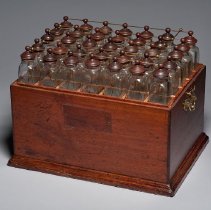Object Record
Images

Metadata
Catalog Number |
58.36 |
Object Name |
Jar, Battery |
Title |
Battery of Leyden Jars |
Artist |
van Musschenbroek, Pieter |
Date |
after 1746 |
Description |
Unmarked except for a brass plaque (not original) stating that the battery was used by Benjamin Franklin. It contains thirty-five jars in seven rows of five, each jar having a height of 12 1/4" and a 2" square cross-section. Each is covered with foil to a height of about 9", and has a wooden cap from which contact wires project within. Through wires laid across the top, the jars are connected in series. This battery has been restored at some point in the past. Fifteen of the Leyden jars appear to be original; twenty are facsimiles and are so marked by a diamond point inscription on one side. The facsimiles were made in a mold which left a burr not present in the original, and are covered with foil on the outside only. (Robert P. Multhauf, "Catalogue of Instruments and Models," 1961). |
Label |
Leyden jars such as these store electric charges. Named after one of the cities in Holland where they were first used in the 1740s, the glass jars are coated inside and out with metal foil. They are charged by bringing the inner conducting rod in contact with the "prime conductor" of an electrical machine. This creates an electrical potential between the two foils. When the foils are connected, the jars are discharged. Benjamin Franklin reportedly owned this battery; it may be one of the numerous pieces of European scientific apparatus he acquired in his later years. |
Material |
Instrument: glass and metal; Box: wood |
Dimensions |
H-14 W-18 D-13 inches |
Dimension Details |
Each jar: 12.25" high x 2" square cross section |
Credit line |
American Philosophical Society. Gift of Joseph Hopkinson, 1836. |
Search Terms |
18th century eighteenth century electricity measurement scientific instrument |
